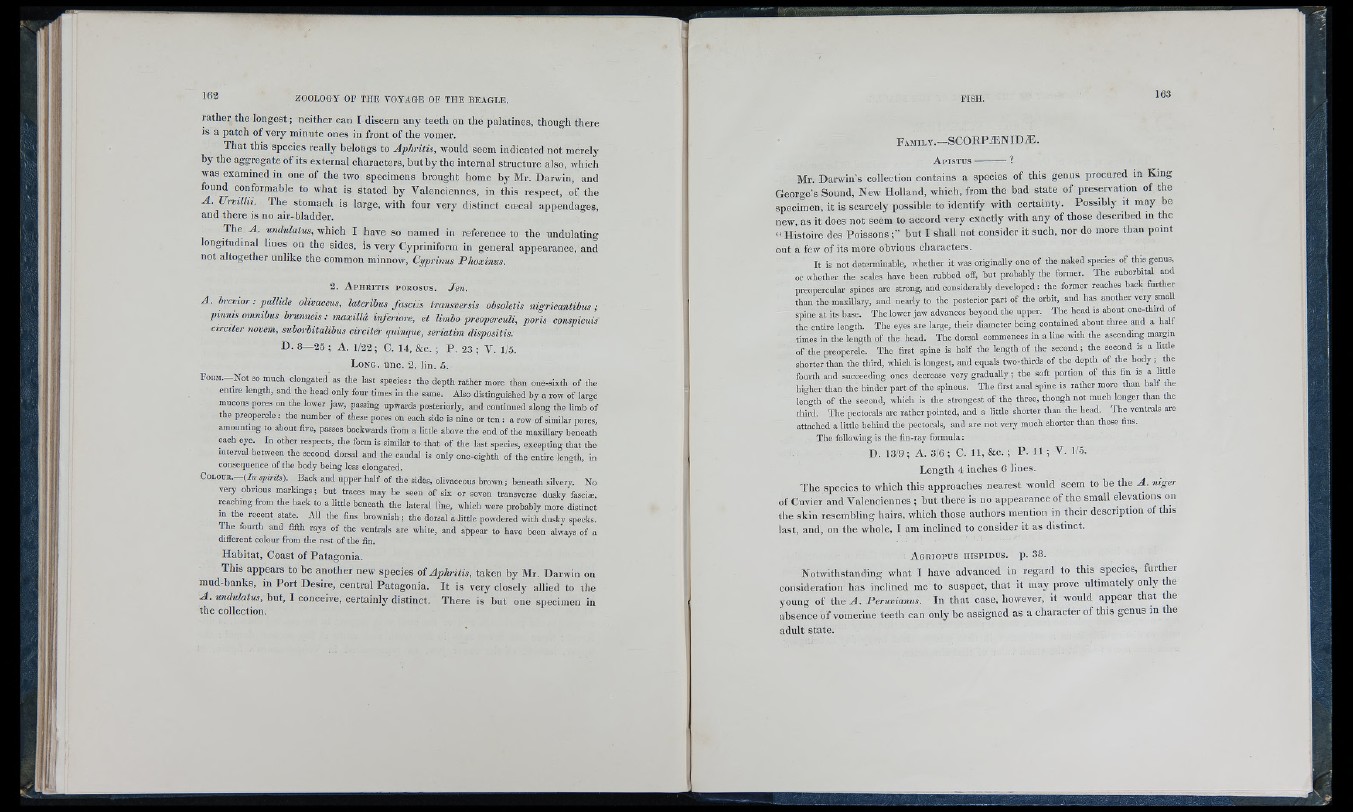
rather the longest ; neither can 1 discern any teeth on the palatines, though there
is a patch of very minute ones in front of the vomer.
That this species really belongs to Aphritis, would seem indicated not merely
by the aggregate of its external characters, but by the internal structure also, which
was examined in one of the two specimens brought home by Mr. Darwin, and
found conformable to what is stated by Valenciennes, in this respect, of the
A . JJrvillii. The stomach is large, with four very distinct coecal appendages,
and there is no air-bladder.
The A . undulatus, which I have so named in reference to the undulating
longitudinal lines on the sides, is very Cypriniforin in general appearance, and
not altogether unlike the common minnow, Cyprinus Phoxmus.
2 . A p h r it is p o ro su s. Jen.
A . I,-emor : pallide olivaceus, laterihus fasciis transversis obsoletis nigricantibus ;
pinnis omnibus brunneis : maxillá inferiore, et limbo preopercuU, poris conspicuts
circiter novem, suborbitalibus circiter quinqué, seriatim dispositis.
D. 8— 25 ; A. 1 /2 2 ; C. 14, & c. ; P. 2 3 ; V. 1/5.
L o n g . u n c . 2 . lin . 5.
FO RM .-N ot so much elongated as the last species; the depth rather more than one-sixth of the
entire length, and the head only four times in the same. Also distinguished by a row of large
muoons pores on the lower jaw, passing upwards posteriorly, and continued along the limb of
the preopercle : the num ber of these pores on each side is nine or ten ; a row of similar pores,
amounting to about five, passes backwards from a little above the end of the maxillary beneath
each eye. In other respects, the form is similar to that of the last species, excepting that the
interval between the second dorsal and the caudal is only one-cighth of the entire length, in
consequence of the body being less elongated.
C0L0U E .-(/,i spirits). Baek and upper half o f the sides, olivaceous brow n; beneath silvery. No
very obvious m arkings; but traces may be seen of six or seven transverse dusky fasciæ,
reaching from the back to a httle beneath the lateral line, which were probably more distinct
m the recent state. A ll the fins brownish ; the dorsal a little powdered with dusky specks.
The fourth and fifth rays of the ventrals are white, and appear to have been always of a
different colour from the rest of the fin.
Habitat, Coast of Patagonia.
This appears to be another new species oí Aphritis, taken by Mr. Darwin on
inud-banks, in Port Desire, central Patagonia. It is very closely allied to the
A . undulatus, but, I conceive, certainly distinct. There is but one specimen in
the collection.
FA M iL v.-S C O R PiE N ID ^.
A p i s t u s -------------- 1
Mr. Darwin's collection contains a species of this genus procured in King
George’s Sound, New Holland, wliich, from the bad state of preservation of the
specimen, it is scarcely possible to identify with certainty. Possibly it may be
new, as it does not seem to accord very exactly with any of those described m the
“ Histoire des Poissons but I shall not consider it such, nor do more than point
out a few of its more obvious characters.
It is not determinable, whether it was originally one of the naked species of this genus,
or whether the scales have been rubbed off, but probably tbe former. T he suborhital and
preopercular spines are strong, and considerably developed: tbe former reaches back further
than the maxillary, and nearly to tbe posterior part of the orbit, and has another very small
spine at its base. T he lower jaw advances beyond the upper. T h e head is about one-third of
the entire length. T he eyes are large, their diameter being contained about three and a half
times in the length of the head. T he dorsal commences in a line with the ascending margin
o f the preopercle. The first spine is half the length o f the second; the second is a little
shorter than the third, which is longest, and equals two-thirds of the depth of the body ; the
fourth and succeeding ones decrease very gradually; the soft portion of this fin is a little
higher than the hinder p art of the spinous. T he first anal spine is rather more than half the
length of the second, which is the strongest o f the three, though not much longer than the
third. The pectorals are rather pointed, and a little shorter than the bead. T h e ventrals are
attached a little behind the pectorals, and are not very much shorter than those fins.
The following is tlie fin-ray formula:
D. 13,9; A. 3/0; C. 11, &c. ; P . 11 ; V. 1/5.
Length 4 inches 6 lines.
The species to which this approaches nearest would seem to be the A . niger
of Cuvier aud Valenciennes ; but there is no appearance of the small elevations on
the skin resembling hairs, whicli those authors mention in their description of this
last, and, on the whole, I am inclined to consider it as distinct.
A o e i o p u s h i s p i d u s . p. 38.
Notwithstanding what I have advanced in regard to this species, further
consideration has inclined me to suspect, that it may prove ultimately only the
young of the A. Peruvianus. In that case, however, it would appear that the
absence of vomerine teeth can only he assigned as a character of this genus in the
adult state.